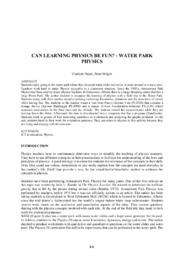Can learning physics be fun? - Water park Physics
Abstract
Students enjoy going to the water park where they descend water slides and swim or jump around in a wave pool.
Teachers work hard to make Physics enjoyable in a classroom situation. Since the 1980’s, Amusement Park
Physics has been used by many physics teachers. In Edmonton, Alberta there is a large shopping center that has a
large Water Park. The author decided to integrate the learning of physics with a field trip to the Water Park.
Students along with their teacher spend a morning reviewing kinematics, dynamics and the principles of waves
while having fun. The students or the teacher wears a vest from Pasco (Xplorer Vest PS-2520) that contains a
storage device (Xplorer Datalogger PS-2000) and a sensor (3-Axis Acceleration-Altimeter PS-2136) which
measures acceleration in the three axes and the altitude. The students record the measurements while they are
moving down the slides. Afterwards the data is downloaded into a computer that has a program (DataStudio).
Students work in groups of four answering questions on worksheets and analyzing the graphs produced. At the
end, students hand in their work for evaluation purposes. They can relate to physics in this activity because they
are living and playing with the concepts.
